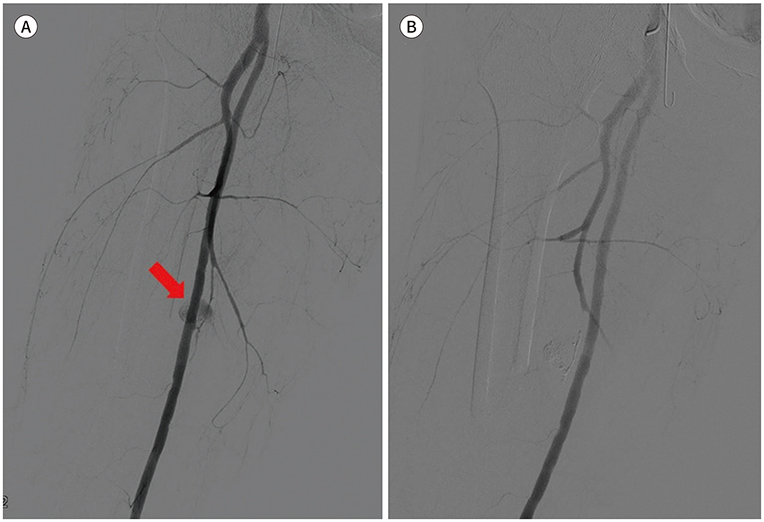J Korean Soc Radiol.
2019 Jul;80(4):761-767. 10.3348/jksr.2019.80.4.761.
Transcatheter Arterial Embolization with N-Butyl Cyanoacrylate for Profunda Femoris Artery Pseudoaneurysms Caused by Femur Shaft Fractures: Two Case Reports
- Affiliations
-
- 1Department of Radiology, Chungbuk National University Hospital, Cheongju, Korea. sixtwin@hanmail.net
- 2Department of Radiology, College of Medicine and Medical Research Institute, Chungbuk National University, Cheongju, Korea.
- KMID: 2457454
- DOI: http://doi.org/10.3348/jksr.2019.80.4.761
Abstract
- Pseudoaneurysm formation in the profunda femoris artery (PFA) is a rare complication of femur shaft fractures or, more usually, a consequence of operative repair. Over the past few years, percutaneous transcatheter arterial embolization (TAE) has increasingly been considered the most effective treatment for pseudoaneurysms of the PFA. We report two cases with pseudoaneurysms of the PFA that were caused by femur shaft fractures and were successfully treated using TAE with n-butyl cyanoacrylate (NBCA). When a pseudoaneurysm of the PFA occurs due to a femur shaft fracture, early recognition and prompt radiologic intervention may prevent severe vascular injury without the need for additional surgery. The advent of TAE using NBCA enables minimally invasive treatment to be undertaken and it is effective for managing pseudoaneurysms of the PFA.
MeSH Terms
Figure
Reference
-
1. Hanna GB, Holdsworth RJ, McCollum PT. Profunda femoris artery pseudoaneurysm following orthopaedic procedures. Injury. 1994; 25:477–479.
Article2. Entwisle JJ, De Nunzio M, Hinwood D. Case report: transcatheter embolization of pseudoaneurysm of the profunda femoris artery complicating fracture of the femoral neck. Clin Radiol. 2001; 56:424–427.3. Waldherr C, Kickuth R, Ludwig K, Do DD, Triller J. Superselective embolization of deep femoral artery branch pseudoaneurysm with a coaxial microcatheter system. Vasa. 2006; 35:45–49.
Article4. Loubeau JM, Bahnson HT. Traumatic false aneurysm and arteriovenous fistula of the profunda femoris artery: surgical management and review of the literature. Surgery. 1977; 81:222–227.5. Chong KC, Yap EC, Lam KS, Low BY. Profunda femoris artery pseudoaneurysm presenting with triad of thigh swelling, bleeding and anaemia. Ann Acad Med Singapore. 2004; 33:267–269.6. Naouli H, Jiber H, Bouarhroum A. False aneurysm of perforating branch of the deep femoral artery-report of two cases. Int J Surg Case Rep. 2015; 14:36–39.
Article7. Miller-Thomas MM, West OC, Cohen AM. Diagnosing traumatic arterial injury in the extremities with CT angiography: pearls and pitfalls. Radiographics. 2005; 25:Suppl 1. S133–S142.
Article8. Walker TG, Geller SC, Brewster DC. Transcatheter occlusion of a profunda femoral artery pseudoaneurysm using thrombin. AJR Am J Roentgenol. 1987; 149:185–186.
Article9. Sedwitz MM, Hye RJ, Stabile BE. The changing epidemiology of pseudoaneurysm. Therapeutic implications. Arch Surg. 1988; 123:473–447.10. Yamakado K, Nakatsuka A, Tanaka N, Takano K, Matsumura K, Takeda K. Transcatheter arterial embolization of ruptured pseudoaneurysms with coils and n-butyl cyanoacrylate. J Vasc Interv Radiol. 2000; 11:66–72.
Article
- Full Text Links
- Actions
-
Cited
- CITED
-
- Close
- Share
- Similar articles
-
- Percutaneous N-Butyl Cyanoacrylate Embolization of a Pancreatic Pseudoaneurysm after Failed Attempts of Transcatheter Embolization
- Multiple Cerebral Infarction after Injection of N-Butyl-2-Cyanoacrylate for Gastric Variceal Bleeding
- Transcatheter Arterial Embolization of Cystic Artery Pseudoaneurysm in Acalculous Cholecystitis: A Case Report
- Transcatheter Arterial Embolization of Arterial Esophageal Bleeding with the Use of N-Butyl Cyanoacrylate
- Inferior Mesenteric Artery Embolization with N-Butyl Cyanoacrylate for Life-Threatening Postpartum Hemorrhage: A Report of Two Cases and Literature Review



